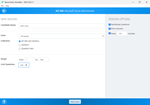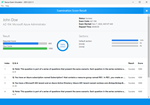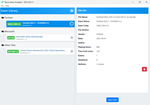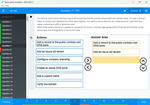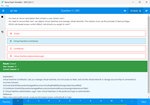Download FCP - FortiWeb 7.4 Administrator.FCP_FWB_AD-7.4.VCEplus.2025-03-22.20q.tqb
| Vendor: | Fortinet |
| Exam Code: | FCP_FWB_AD-7.4 |
| Exam Name: | FCP - FortiWeb 7.4 Administrator |
| Date: | Mar 22, 2025 |
| File Size: | 748 KB |
How to open TQB files?
Files with TQB (Taurus Question Bank) extension can be opened by Taurus Exam Studio.
Purchase
Coupon: TAURUSSIM_20OFF
Discount: 20%
Demo Questions
Question 1
How are bot machine learning (ML) models different from API or anomaly detection models?
- Bot ML models analyze multiple connections overtime instead analyzing each connection as a single unit.
- Bot ML models detect only anomalies and not actual threats.
- Bot ML models inspect more types of connection properties.
- Bot ML models do not update models periodically from new data.
Correct answer: A
Explanation:
Bot ML models analyze multiple connections over time instead of analyzing each connection as a single unit: This is the key distinction. Bot ML models focus on analyzing patterns over a period of time, looking at behavioral patterns across multiple requests or connections from the same source to identify potential bot activity. Unlike traditional anomaly detection or API models that may focus on single connections or individual transactions, bot detection typically examines aggregated behavior to identify patterns indicative of bots, such as high-frequency requests or unusual traffic flows. Bot ML models analyze multiple connections over time instead of analyzing each connection as a single unit: This is the key distinction. Bot ML models focus on analyzing patterns over a period of time, looking at behavioral patterns across multiple requests or connections from the same source to identify potential bot activity. Unlike traditional anomaly detection or API models that may focus on single connections or individual transactions, bot detection typically examines aggregated behavior to identify patterns indicative of bots, such as high-frequency requests or unusual traffic flows.
Question 2
In which two operating modes can FortiWeb modify HTTP packets? (Choose two.)
- True transparent proxy
- Virtual proxy
- Transparent inspection
- Reverse proxy
Correct answer: BD
Explanation:
Virtual proxy: In virtual proxy mode, FortiWeb acts as an intermediary between clients and the server, and it can modify HTTP packets. It performs various security checks, such as inspecting and filtering HTTP traffic before forwarding it to the web server.Reverse proxy: In reverse proxy mode, FortiWeb sits between the client and the server, handling incoming requests from clients, modifying or inspecting HTTP packets as needed, and forwarding them to the backend servers. Virtual proxy: In virtual proxy mode, FortiWeb acts as an intermediary between clients and the server, and it can modify HTTP packets. It performs various security checks, such as inspecting and filtering HTTP traffic before forwarding it to the web server.
Reverse proxy: In reverse proxy mode, FortiWeb sits between the client and the server, handling incoming requests from clients, modifying or inspecting HTTP packets as needed, and forwarding them to the backend servers.
Question 3
Which three security features must you configure on FortiWeb to protect API connections? (Choose three.)
- Single sign-on (SSO) authentication with Active Directory (AD)
- Machine learning (ML)-based API protection
- API schema validation
- API user authentication with SAML
- API user key enforcement
Correct answer: BCE
Explanation:
Machine learning (ML)-based API protection: ML-based API protection helps detect and mitigate abnormal behavior in API traffic, such as bot attacks or abuse, by learning and adapting to normal traffic patterns.API schema validation: API schema validation ensures that the API requests conform to the defined schema (e.g., checking the structure, fields, and types in the API calls). This helps prevent attacks like XML or JSON injection by ensuring only valid requests are processed.API user key enforcement: Enforcing API user key authentication requires clients to provide valid API keys, ensuring only authorized users can access the API. This is crucial for controlling access to the API. Machine learning (ML)-based API protection: ML-based API protection helps detect and mitigate abnormal behavior in API traffic, such as bot attacks or abuse, by learning and adapting to normal traffic patterns.
API schema validation: API schema validation ensures that the API requests conform to the defined schema (e.g., checking the structure, fields, and types in the API calls). This helps prevent attacks like XML or JSON injection by ensuring only valid requests are processed.
API user key enforcement: Enforcing API user key authentication requires clients to provide valid API keys, ensuring only authorized users can access the API. This is crucial for controlling access to the API.
Question 4
Which Layer 7 routing method does FortiWeb support?
- URL policy routing
- OSPF
- BGP
- HTTP content routing
Correct answer: D
Explanation:
FortiWeb is a Web Application Firewall (WAF) designed to protect web applications from various threats. Among its features, FortiWeb supports Layer 7 routing methods, which operate based on the content of the HTTP/HTTPS traffic.HTTP Content Routing refers to the capability of directing incoming web traffic to specific backend servers based on characteristics found within the HTTP requests, such as URL paths, headers, or other content. This allows for more granular and efficient distribution of traffic, ensuring that requests are handled by the appropriate servers based on their content.Analysis of Options:A . URL policy routing: While this term suggests routing decisions based on URL policies, it is not a standard term used in FortiWeb's documentation. FortiWeb's content routing encompasses URL-based decisions, making this option less precise.B . OSPF (Open Shortest Path First): This is a Layer 3 routing protocol used for IP routing within an Autonomous System. It operates at the network layer and is not related to Layer 7 routing methods. C . BGP (Border Gateway Protocol): Another Layer 3 routing protocol, BGP is used for routing between Autonomous Systems on the internet. It does not pertain to Layer 7 or application-layer routing.D . HTTP content routing: This aligns with FortiWeb's capabilities to make routing decisions based on the content of HTTP requests, such as URL paths, headers, or other application-layer data. This is a Layer 7 routing method supported by FortiWeb.Therefore, the correct answer is D. HTTP content routing.FortiWeb 7.2.6 Administration Guide: 'FortiWeb provides advanced Layer 7 load balancing and authentication offload services.' cloud.orange-business.comFortiWeb Data Sheet: 'FortiWeb provides advanced Layer 7 load balancing and authentication offload services.' Exclusive NetworksFortiWeb on OCB-FE - Installation and Deployment Guide: 'FortiWeb provides advanced Layer 7 load balancing and authentication offload services.' cloud.orange-business.comThese references confirm that FortiWeb supports HTTP content routing as a Layer 7 routing method. FortiWeb is a Web Application Firewall (WAF) designed to protect web applications from various threats. Among its features, FortiWeb supports Layer 7 routing methods, which operate based on the content of the HTTP/HTTPS traffic.
HTTP Content Routing refers to the capability of directing incoming web traffic to specific backend servers based on characteristics found within the HTTP requests, such as URL paths, headers, or other content. This allows for more granular and efficient distribution of traffic, ensuring that requests are handled by the appropriate servers based on their content.
Analysis of Options:
A . URL policy routing: While this term suggests routing decisions based on URL policies, it is not a standard term used in FortiWeb's documentation. FortiWeb's content routing encompasses URL-based decisions, making this option less precise.
B . OSPF (Open Shortest Path First): This is a Layer 3 routing protocol used for IP routing within an Autonomous System. It operates at the network layer and is not related to Layer 7 routing methods.
C . BGP (Border Gateway Protocol): Another Layer 3 routing protocol, BGP is used for routing between Autonomous Systems on the internet. It does not pertain to Layer 7 or application-layer routing.
D . HTTP content routing: This aligns with FortiWeb's capabilities to make routing decisions based on the content of HTTP requests, such as URL paths, headers, or other application-layer data. This is a Layer 7 routing method supported by FortiWeb.
Therefore, the correct answer is D. HTTP content routing.
FortiWeb 7.2.6 Administration Guide: 'FortiWeb provides advanced Layer 7 load balancing and authentication offload services.' cloud.orange-business.com
FortiWeb Data Sheet: 'FortiWeb provides advanced Layer 7 load balancing and authentication offload services.' Exclusive Networks
FortiWeb on OCB-FE - Installation and Deployment Guide: 'FortiWeb provides advanced Layer 7 load balancing and authentication offload services.' cloud.orange-business.com
These references confirm that FortiWeb supports HTTP content routing as a Layer 7 routing method.
Question 5
Which command will enable debugging for the FortiWeb user tracking feature?
- debug enable user-tracking 7
- diagnose debug application user-cracking 7
- debug application user-cracking 7
- diagnose debug enable user-cracking 7
Correct answer: B
Explanation:
To enable debugging for the user tracking feature in FortiWeb, you would use the command diagnose debug application user-tracking 7. This command enables debugging for the user-tracking application and sets the debug level to 7, providing detailed logs for troubleshooting. To enable debugging for the user tracking feature in FortiWeb, you would use the command diagnose debug application user-tracking 7. This command enables debugging for the user-tracking application and sets the debug level to 7, providing detailed logs for troubleshooting.
Question 6
Refer to the exhibit.

What is true about this FortiWeb device? (Choose two.)
- It has 41% of the disk available for logging.
- It was upgraded to a different version after initial installation.
- It is currently running version 6.4.0.
- It is currently running version 6.4.1.
Correct answer: B
Explanation:
It was upgraded to a different version after initial installation: The device has multiple partitions with different firmware versions (6.4.0 and 6.4.1), indicating that it was upgraded after the initial installation from version 6.4.0 to 6.4.1. It was upgraded to a different version after initial installation: The device has multiple partitions with different firmware versions (6.4.0 and 6.4.1), indicating that it was upgraded after the initial installation from version 6.4.0 to 6.4.1.
Question 7
Which high availability (HA) mode uses gratuitous Address Resolution Protocol (ARP) to advertise a failover event to neighboring network devices?
- Passive-Passive
- Active-Passive
- Active-Active
- Passive-Active
Correct answer: B
Explanation:
In Active-Passive high availability (HA) mode, the active unit is responsible for handling traffic while the passive unit remains idle, ready to take over in case of a failure. When a failover occurs, the active unit sends out gratuitous ARP messages to notify neighboring devices about the change in the active unit's IP address. This ensures that the network devices update their ARP tables and can forward traffic to the new active unit. In Active-Passive high availability (HA) mode, the active unit is responsible for handling traffic while the passive unit remains idle, ready to take over in case of a failure. When a failover occurs, the active unit sends out gratuitous ARP messages to notify neighboring devices about the change in the active unit's IP address. This ensures that the network devices update their ARP tables and can forward traffic to the new active unit.
Question 8
In SAML deployments, which server contains user authentication credentials (username/password)?
- Identity provider
- Service provider
- User database
- Authentication client
Correct answer: A
Explanation:
In SAML (Security Assertion Markup Language) deployments, the Identity Provider (IdP) is responsible for storing and managing user authentication credentials, such as usernames and passwords. The IdP authenticates the user and then issues a SAML assertion to the Service Provider (SP), which allows the user to access services without needing to re-enter credentials. In SAML (Security Assertion Markup Language) deployments, the Identity Provider (IdP) is responsible for storing and managing user authentication credentials, such as usernames and passwords. The IdP authenticates the user and then issues a SAML assertion to the Service Provider (SP), which allows the user to access services without needing to re-enter credentials.
Question 9
What are two possible impacts of a DoS attack on your web server? (Choose two.)
- The web application starts accepting unencrypted traffic.
- The web application is unable to accept any more connections because of network socket exhaustion.
- The web application server is unable to accept new client sessions due to memory exhaustion.
- The web application server database is compromised with data theft.
Correct answer: BC
Explanation:
The web application is unable to accept any more connections because of network socket exhaustion: A Denial of Service (DoS) attack often floods the web server with an overwhelming number of requests, leading to network socket exhaustion. This can prevent the server from accepting new legitimate connections, effectively disrupting service.The web application server is unable to accept new client sessions due to memory exhaustion: DoS attacks can consume a significant amount of server memory, causing memory exhaustion. This results in the web application being unable to accept new client sessions or handle requests properly. The web application is unable to accept any more connections because of network socket exhaustion: A Denial of Service (DoS) attack often floods the web server with an overwhelming number of requests, leading to network socket exhaustion. This can prevent the server from accepting new legitimate connections, effectively disrupting service.
The web application server is unable to accept new client sessions due to memory exhaustion: DoS attacks can consume a significant amount of server memory, causing memory exhaustion. This results in the web application being unable to accept new client sessions or handle requests properly.
Question 10
Which two items can be defined in a FortiWeb XML Protection Rule? (Choose two.)
- API key
- IXML Schema
- Web protection profile
- Request URL
Correct answer: BD
Explanation:
XML Schema: In FortiWeb, XML protection rules allow you to define an XML Schema to validate the structure and content of incoming XML documents. This helps protect against attacks like XML injection by ensuring that only well-formed XML requests are processed.Request URL: You can define a request URL as part of an XML protection rule to specify the URL pattern for which the rule should apply. This allows you to apply different XML protection rules to different endpoints or resources based on the URL. XML Schema: In FortiWeb, XML protection rules allow you to define an XML Schema to validate the structure and content of incoming XML documents. This helps protect against attacks like XML injection by ensuring that only well-formed XML requests are processed.
Request URL: You can define a request URL as part of an XML protection rule to specify the URL pattern for which the rule should apply. This allows you to apply different XML protection rules to different endpoints or resources based on the URL.
HOW TO OPEN VCE FILES
Use VCE Exam Simulator to open VCE files
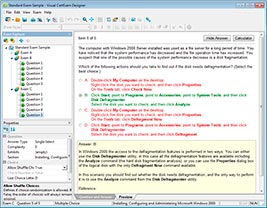
HOW TO OPEN VCEX FILES
Use ProfExam Simulator to open VCEX files
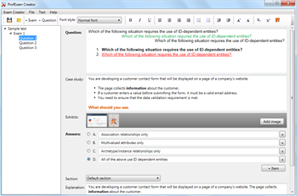
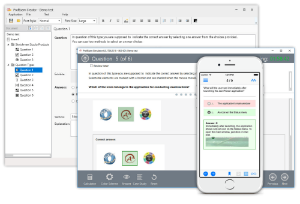
ProfExam at a 20% markdown
You have the opportunity to purchase ProfExam at a 20% reduced price
Get Now!